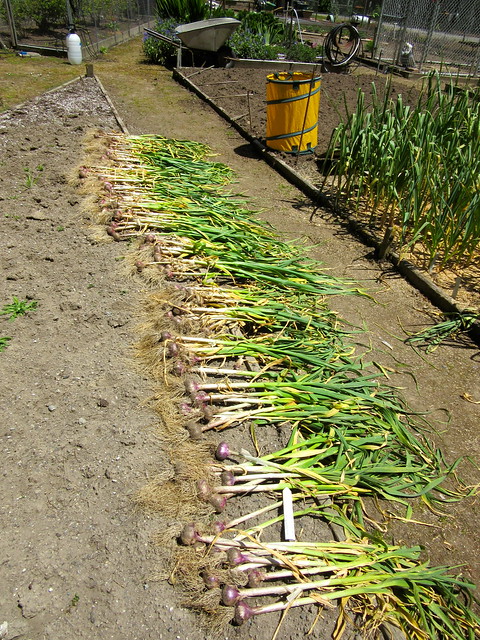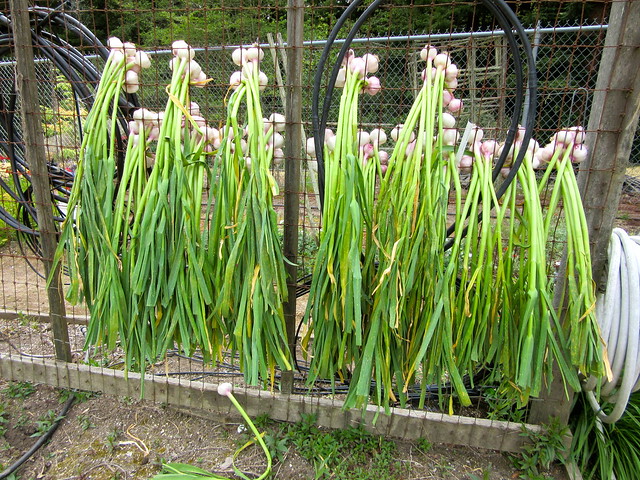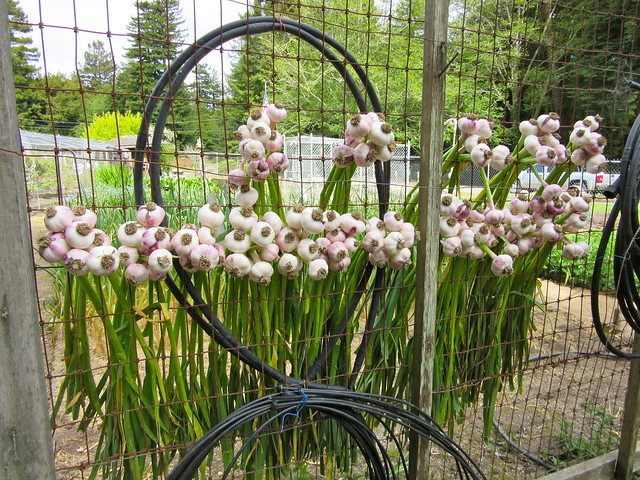The weather has been dry but it didn't hurt the early Chinese Pink Garlic ~~~




The rest of the later crop will be dug in a month or less ~
Posted on 05/15/2015 1:19:16 PM PDT by greeneyes
The Weekly Gardening Thread is a weekly gathering of folks that love soil, seeds and plants of all kinds. From complete newbies that are looking to start that first potted plant, to gardeners with some acreage, to Master Gardener level and beyond, we would love to hear from you. This thread is non-political, although you will find that most here are conservative folks.
No matter what, you won’t be flamed and the only dumb question is the one that isn’t asked. It is impossible to hijack the Weekly Gardening Thread. Planting, Harvest to Table(recipes)preserving, good living - there is no telling where it will go and... that is part of the fun and interest. Jump in and join us!
NOTE: This is a once a week ping list. We do post to the thread during the week. Links to related articles and discussions which might be of interest are welcomed, so feel free to post them at any time.
Will it thrive in the flower box and if at the end of the season I bring the box into the garage for the winter, will it survive till next spring?
Good to see you on this forum - do you have any friends and/or neighbors that garden?
Sharing trial-and-error with others helps everyone learn - I've gotten (and given) some pretty good pointers from others in my zone - and it's great fun, too!
Hey Psalm,
Yeah, the people to one side of us have a garden every now and then, I may be able to ask them also. Good idea. Thanks.
What is your growing zone? Here in NC we got down below 10 degrees (I think 9 was the lowest). I was surprise that so many plants actually made it through the winter. The two newest we just planted in mid to late August. My mom had a few irises. They are so graceful and pretty.
Radishes and arugula are the zucchini of May.
The Colorado Potato beetle will leave a mass of tan /beige/ light brown eggs.
You can and should remove sucker growth
Best to wait until you see some blooms to determine which is productive for fruit , and which are suckers.
You can train it into an upright growth ( known in horticulture as 'apical meristem' - just select which is likely to grow upward, and trim out the rest
and eliminate the competition for leader.
It sounds like too much, or high nitrogen in the soil.
Consider subsequent plantings of leafey greens (lettuces, brocolli , kohlrobbi, kale, etc. ) as you harvest the radishes, or thin them out .
Mis-marked vegetables generally occur near the end of the planting season .
Frequently , customers will pull a marker our of the flat , forget where it came from , and put it somewhere where is is convienient (to them).
Growers and greenhouses don't purposely mis-mark crops as it ruins their reputation, and turns buyers to go elsewhere.
The weather has been dry but it didn't hurt the early Chinese Pink Garlic ~~~




The rest of the later crop will be dug in a month or less ~
Mostly agree with you .
Till up and loosen the soil( even in raised bed) , then put plastic over it to sterilize the soil.
The reason why I suggest some tillage is to get the heat down deeper into the soil, until the soil temp registers either 160 degrees, or at least 140+ degrees for 5 days.
Butterfly milkweed is pretty durable, you might not need to bring it in. What growing zone are you in?
(PS: Butterly Milkweed is also known as Pleurisy Root, and is used as an antiviral. If you want to, you can grow the roots as a cash crop. Harvest in their 3rd year.)
Thanks.
You’ve confirmed my short search for a cure.
S.E. Michigan.....
Oh my gosh - what beautiful garlic. We love garlic and I think that last fence shot will be my new wallpaper.
We have a fairly early spring here in west Michigan after a brutally cold winter. I planted some seeds a week ago, earliest I have ever planted here in over 30 years. The forecast confirms we will probably not have a late May frost so I am EXCITED. All of my seed plantings are up and yesterday I put in some plants except tomatoes, will probably do those today. I found my bush pickles (Chef Jeff’s) at the nursery so I am content. I tried them last year and was overwhelmed with pickles last year from one plant. They are also very fine eating cucumbers - thin skins. Marcella I hope your seeds sprouted, only one of mine did and it’s tiny yet. I transplanted the romaine I started Easter weekend under plexiglas. Also excited about 2 new radishes, yellow ones from Russia and Ukraine. I love radishes. I feel good this year and have been able to get a lot of prep work done early. The morel mushroom season is also not over. Hoping to find more today as we got a lot of rain and temps will warm up. Johnny if I lived closer I would bring you a nice dish garden of fresh greens. You may not be gardening yet but we are grateful for every post. I love seeing everyone’s pictures and reading about everyone’s gardening. Best thread on FR.
Good point and I would do that as well. Also, if it's a raised bed bring the black plastic all the way around to the ground level.
I have a book called “Hedgemaids & Fairy Candles”, The Life & Lore of North American Wildflowers by Jack Sanders. I highly recommend it.
For milkweed, he says:
Milkweeds are slow spreading and have not been really serious field pests. Farmers though, dislike them because those roots are so hard to eradicate. Moreover, common milkweed has a mother plant, with the deepest roots, which sends out underground runners that sprout other plants nearby. Unless the mother root is killed, colonies cannot be prevented from starting and spreading.
Many people would just as soon have a patch of milkweed. They are handsome plants. Because of the deep roots, successful transplantation of mature plants is difficult. Attempt it only with small offspring of the mother plant in the spring. Better yet, grab a few pods in late August or September and plant the seeds in fairly dry soil that gets plenty of sunlight Seeds may be planted in the fall or spring.
Something else interesting from the book:
Recent research has found that many common milkweeds contain potent, often poisonous substances known as cardiac glycosides (digitalis from foxglove is a cardiac glycoside) It is probably these powerful cardiac glycosides that make monarchs unpalatable. Birds almost immediately become nauseous and vomit for up to a half hour after eating a monarch. Most birds will simply bypass the monarch(and the look-alike viceroy) in the future. Some crafty birds, however, will catch a butterfly and sample a bit of the wing to see if it tastes bad, letting it go if it is a monarch. In Mexico and Central America, where our monarchs spend the winter, there are birds such as grosbeaks and orioles that have learned which parts of the monarch contain the smallest doses of poison and eat only those parts.
Yep, and either way the garden will be OK. Most important right now not to over-do. I'm fixin' to apply that advice to myself as I recover from upcoming surgery this next week.
Actually, you may need to remind me.....:)
I'd remind you to slow down but I don't know who will remind me. ;)
/johnny
Disclaimer: Opinions posted on Free Republic are those of the individual posters and do not necessarily represent the opinion of Free Republic or its management. All materials posted herein are protected by copyright law and the exemption for fair use of copyrighted works.